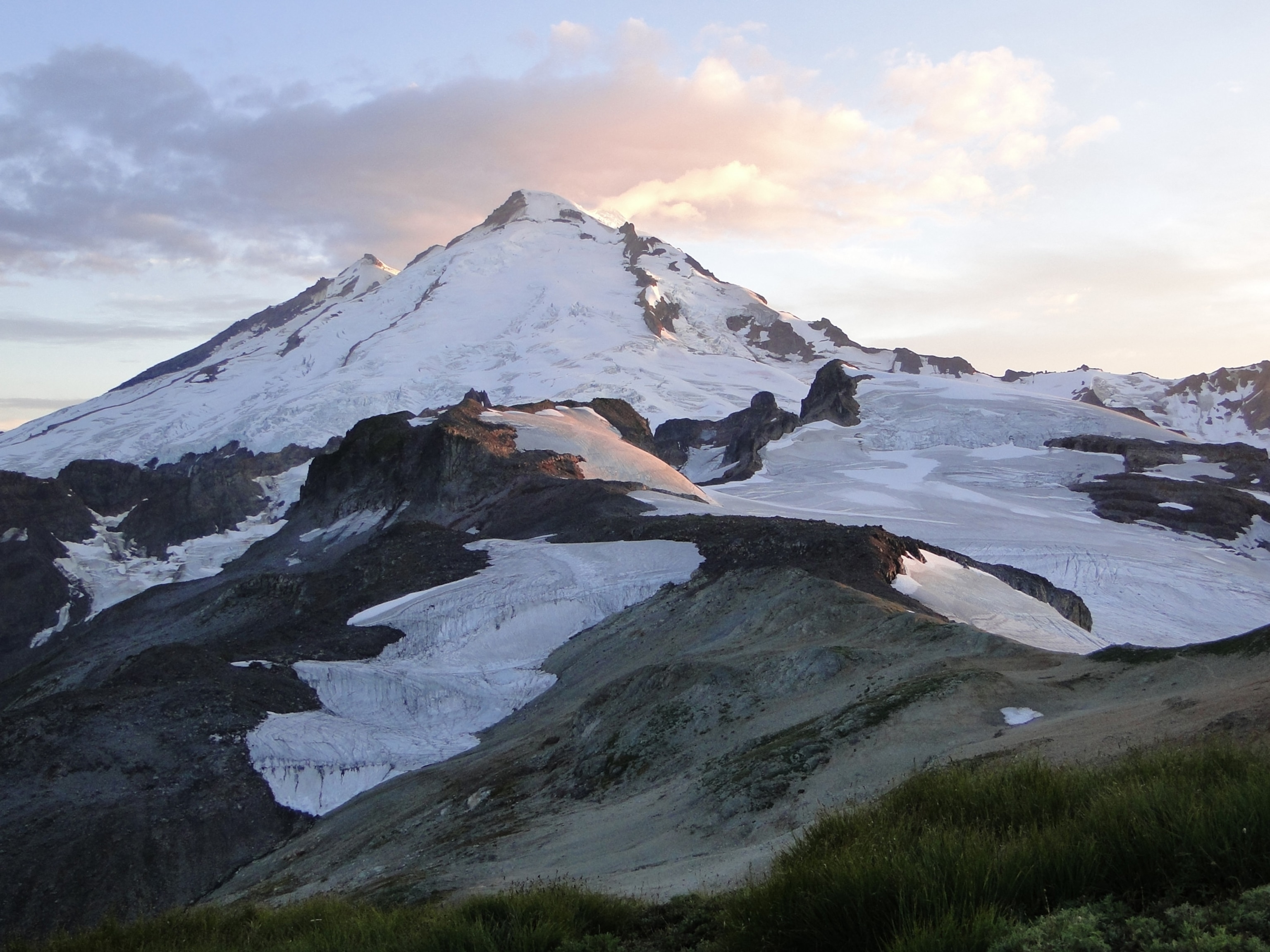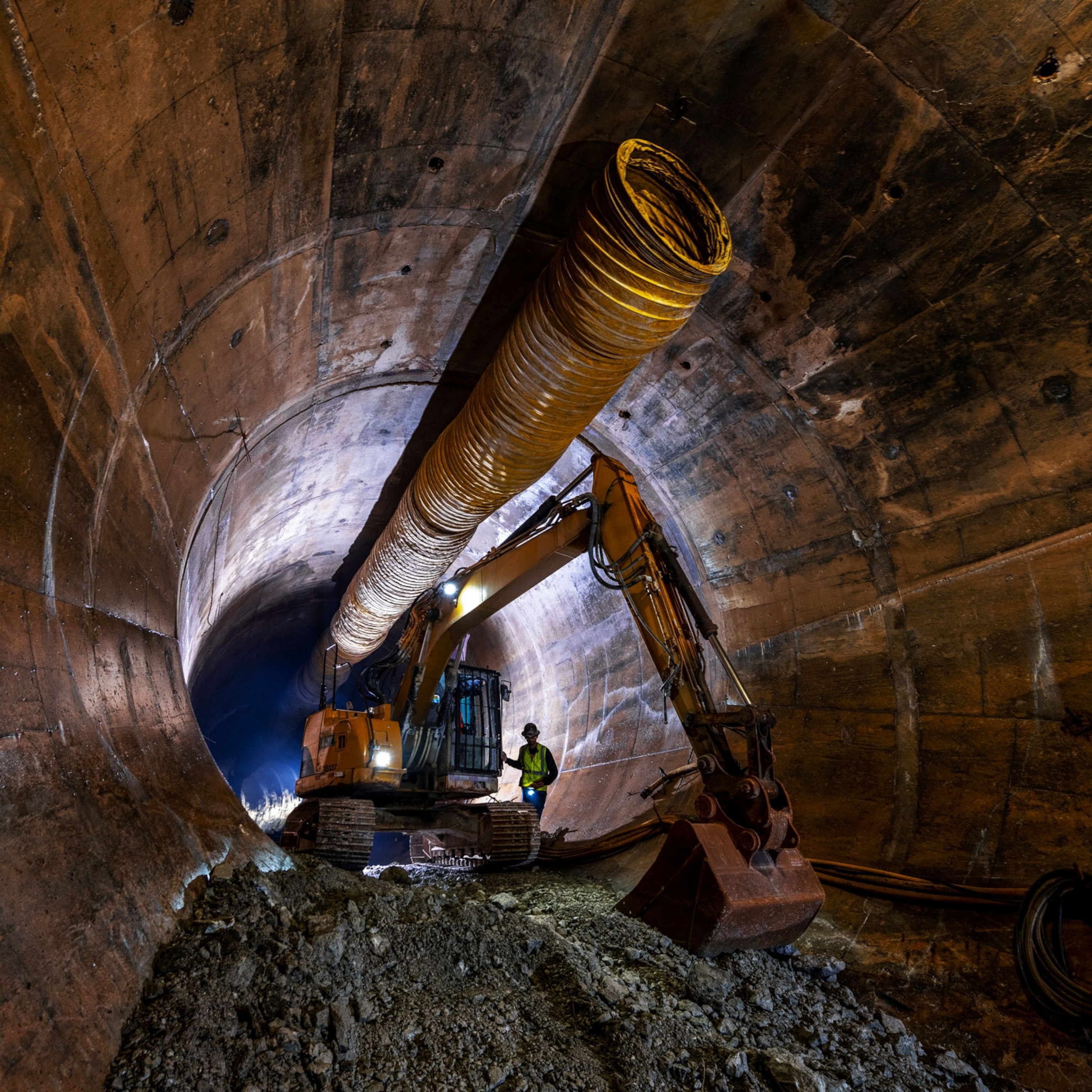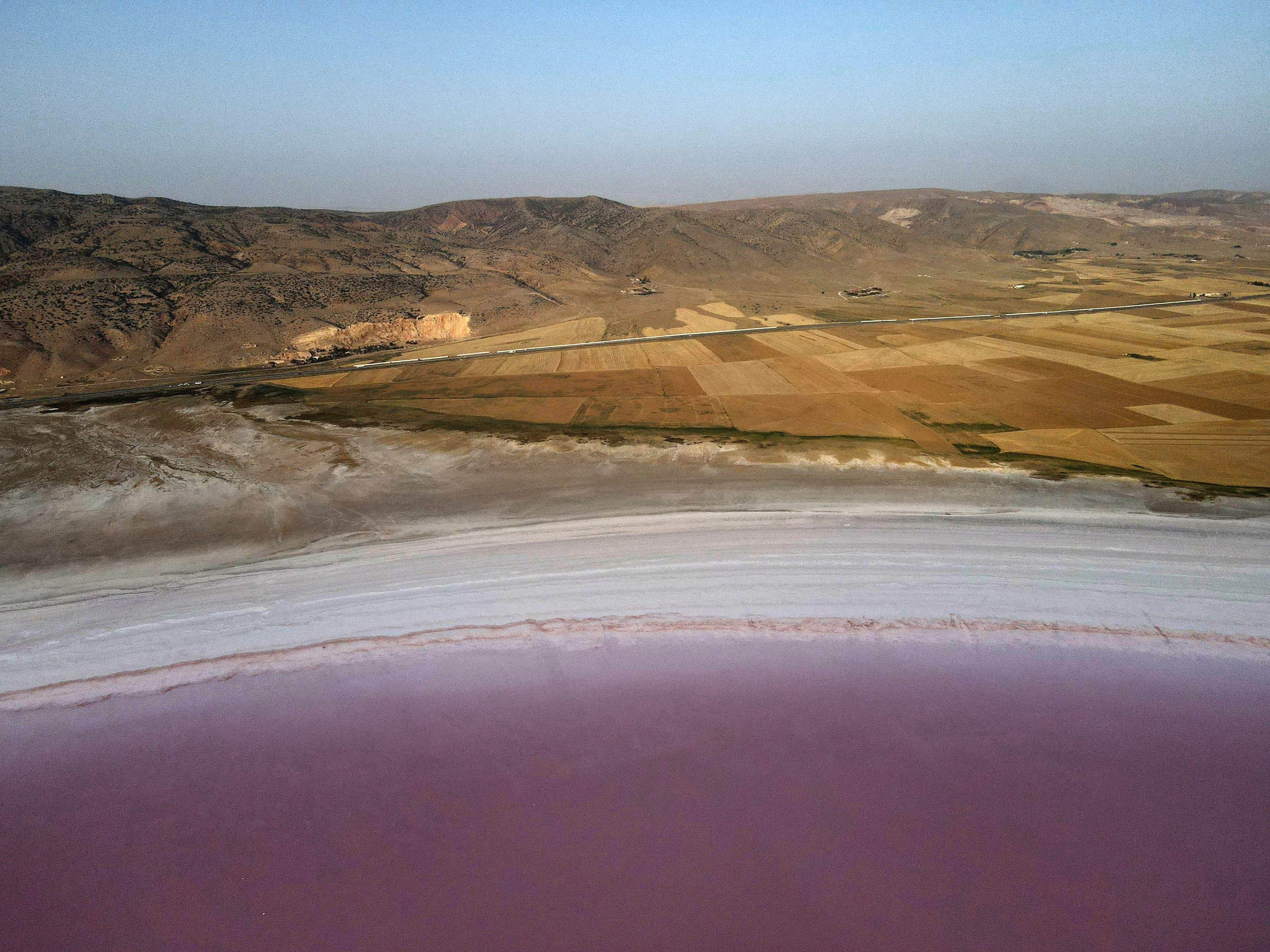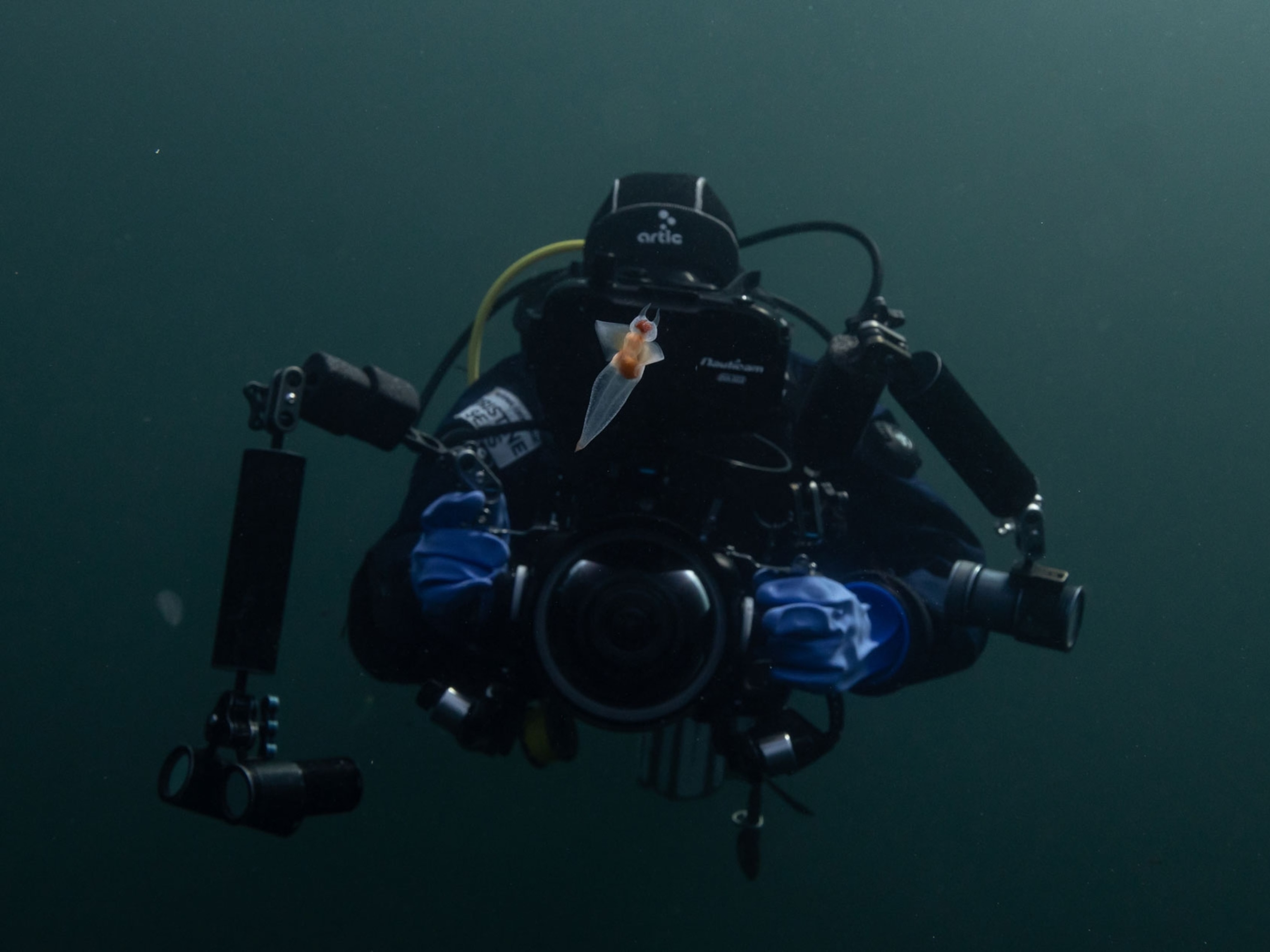
This 50-year project follows the impacts of the Cascades' melting glaciers
One man's long-term study of glaciers in the Cascade Mountains tracks how they complicate freshwater supplies for the valleys that lie below.
On a hot August afternoon, glaciologist Mauri Pelto picks his way across a steep slope of fragmented rock deep in Washington State’s Cascade Mountains. We’re a two-hour drive northeast of Seattle, and we’re far from any defined trails. After a day and a half of hiking, fording creeks, thrashing through tight forest, and climbing chutes, this rocky rise is all that separates us from our destination: the shrinking Columbia Glacier.
(Arctic Ice Isn't Doomed Yet—Here's How to Save It)
The North Cascades, the most remote portion of this mountain range, is the most glaciated region in the Lower 48. Pelto’s been making this trek every year since 1982, when he began an ambitious 50-year project to track the behavior of these glaciers. Their ice is a crucial lifeblood of this region: During the warm months of June through September, they release 25 percent of the region’s total water supply—approximately 230 billion gallons each year—which is fully utilized for power, drinking water, agriculture, and some of the last healthy wild salmon runs on the planet. The glaciers also play a significant role in reflecting sunlight regionally and mitigating climate change.
But they’re rapidly disappearing—and the accelerating disappearance of mountain glaciers worldwide has become one of the most visible and unsettling signs of global warming. The loss of glacial ice not only hastens sea-level rise, it has reduced fresh water supplies relied on by millions of people who live in the valleys below. Mountain glaciers have lost ice at a faster pace in the last 10 years than in the previous decade, according to an analysis of NASA satellite data published in Nature in April. The scientists who studied the data concluded that by mid-century, parts of mountain ranges around the world, including the Cascades and Rocky Mountains, are on track to be ice free.
Pelto’s North Cascades Glacier Climate Project, now in its 38th season, is one of the few studies examining the movement of glaciers across an entire range to understand the full impact of climate change. In 1980, the North Cascades held 780 glaciers; today, Pelto says, the count is down to about 600. Three of the glaciers Pelto included in his project when he began have already disappeared, and the Columbia Glacier has receded nearly 700 feet. By mid-century, it, too, will be gone.
As we hike up the last near-vertical stretch of glacier-carved rock, I ask Pelto what it’s like to spend his life studying what’s known to be disappearing from the world.
“Most things on Earth are mortal,” he replies. “And so are glaciers. When they’re gone, you lose something that’s natural and beautiful and a resource. There will be something else there, but it’s not that. You’ve lost a dimension of the landscape that you can’t replace.”
Tracking disappearing ice
Pelto’s research is also one of the few monitoring projects that doesn’t use helicopters for access, and relies on ground observations rather than aerial imagery. He estimates he’s covered over 5,000 miles and ascended more than 160,000 feet, all on foot. His study glaciers lie in the northernmost 100 miles of Washington’s Cascade range, a rugged stretch so notorious for foul weather, even in August, that his window for field research is just 16 straight days. He’s 59 now. He’ll be 71 years old when the project is complete, and doesn’t plan to take a season off.
This year, he’s worried how “his” glaciers fared. Although the snowpack last winter in the Cascades ranged from 123 percent to 157 percent of normal, a summer of record-breaking heat waves in the Pacific Northwest will trump that accumulation, translating to “a huge loss” of snow and ice, he says.
Pelto, who teaches environmental science at Nichols College in central Massachusetts, grew up skiing in Michigan with aspirations to qualify for the U.S. Olympic Ski Team. A summer job working on an Alaskan glacier research project hooked him on glaciology instead.
In 1982, Pelto still a graduate student when he began his North Cascades project. Out of hundreds of glaciers in the range, he narrowed his study to 50 that he would visit periodically, and 10—representing small, mid-sized, and large—to visit each summer for five decades. He’s since developed the first model for forecasting glacier survival and serves as the U.S. ambassador to the World Glacier Monitoring Service, which tracks 42 glaciers globally, including three within Pelto’s project.
At the start, two of his study glaciers on Mount Baker, one of five active volcanoes in Washington State, were advancing. Now, all of his study glaciers are in retreat. By 2018, Pelto had measured a 30 percent loss of volume since 1984.
With our current climate, we’re going to lose at least 70 percent of the glaciers. Another degree of warming and we’ll lose all of them.
Glaciologist Mauri Pelto
Measuring the mass balance of a glacier
As we arrive at the lower edge of the Columbia, Pelto surveys the scene. Blanketing a deep cirque, the glacier is relatively flat, with snow fields clinging to the basin walls. A few small patches of blue ice show through the snow, and a milky lake about 100 feet across lies mostly hidden under old summer avalanche debris.
As he pulls out crampons and an ice ax, he points to the close edge of the turbid lake, created as the terminus—the lower end of the glacier—retreated from that spot.
“I see new alpine lakes like this one forming, and I wonder how life is born in them,” he says. “Whatever life is lost by the climate changing is going to be replaced by some other kind. It’s a science project waiting to happen that, to my knowledge, no one’s taken on yet.”
Before GPS devices and cell phones, Pelto honed his topographic skills, carried an altimeter that doubled as a barometer, and read clouds to forecast weather. And, before the snowpack dwindled, he took measurements on skis, carrying them into the glaciers on his back. Now, he points to the rear of the basin at a bare rock pass that the Columbia used to cover before it lost nearly 250 feet of its thickness. He sighs. “It used to be a beautiful ski run.”
We walk up the Columbia’s gentle incline with strategic pauses to probe snow depth and take GPS coordinates and compass readings, which Pelto uses to measure the mass balance of the glacier. He likens it to a checking account. Positive balance is when accumulation exceeds melt and glaciers grow. Negative balance is when melt exceeds accumulation and glaciers retreat.
“A glacier that no longer has a persistent accumulation area has no income anymore,” he says. “It will quickly go bankrupt and disappear. With our current climate, we’re going to lose at least 70 percent of the glaciers. Another degree of warming and we’ll lose all of them.”
The 2018 National Climate Assessment found that temperatures in the Pacific Northwest have warmed almost 2 degrees Fahrenheit since 1900, and warmer winters have led to declines in the snowpack that would add to a glacier’s “income.” The same report projects an increase in average annual temperature in the region from 3.3 to 9.7 degrees Fahrenheit by 2070 to 2090.
Once gaining, now receding
Pelto begins hiking up one of the perennial snowfields on the glacier maintained by late spring and summer avalanches coming off snowfields and smaller glaciers out of sight far above. That extra snow deposit “is what’s going to save a glacier like this for longer,” he says, by keeping the blue ice insulated from heat. But when those small glaciers above have disappeared and those pockets no longer fill with snow, the Columbia will recede even faster.
This is the kind of crucial nuance in glacial behavior that aerial imagery can’t pick up. “That’s the reason to walk around the glaciers every year,” Pelto says. “You develop an understanding of them. It’s the same reason a doctor has you come in for an in-person visit to examine you.”
Over the decades, Pelto has seen firsthand the inexorable changes that occur as the Columbia recedes and its cooling effects retreat farther up the valley. Treelines rise, alpine environments expand, seasonal bloom cycles change, streams and rivers shrink, and barriers to civilization shrivel. Wildlife that prefers rocky slopes near alpine meadows retreats further up those slopes as the meadows expand.
“If you’re a marmot, recession might allow more dogs to come into the area, interrupting feeding cycles because hikers can now access what used to be a steep glacier tongue,” he explains. “Mountain goats, certain bears—a lot of wildlife prospers in the remoteness that glaciers provide.”
Mike Larrabee, a physical scientist in North Cascades National Park, says Pelto’s work is an accurate predictor of which glaciers will persist longer—and that, in turn, provides insights about the places “that will become pockets of refugia for wildlife.”
Knowing which glaciers will persist helps
After two nights camping under the Columbia Glacier, we drive north to Mount Baker, the most heavily glaciated peak after Mount Rainier. Just 16 miles from the Canadian border, we’re now on the Sholes Glacier, one of the large glaciers on Baker’s north flank.
“This is the sound of melt,” Pelto says, then falls silent to listen to the water rushing through ice canyons every few meters across a city block-sized patch of exposed blue ice. “It’s indicative of a high melt year. I never saw this kind of thing until 2005. Now it looks like this every few years.”
We’re joined on the Sholes by Pelto’s daughter, Jill, who’s been accompanying him every year since she was 16. Now 29, she’s one of the preeminent painters using imagery to communicate climate change science.
“I’ll show you where the ice was when Jill first came,” Pelto says, as we remove our crampons and step off the ice onto bare rock. He walks until we’re a football field’s length away from the end. “Right here. It’s retreated so fast since 2009. And it really took off in 2013. Everything you see now at the terminus that’s less than three meters thick—that will all be gone by the end of summer.”
The Sholes has receded 508 feet (155 meters) since 1982. I ask Pelto if he has any emotions about such retreat. “These places were healthy when I first started working on them. They were advancing, powerful things that were active, dynamic geographic features. And to watch them lose that… yeah, it’s emotional.”
We walk along Sholes Creek to where it rushes off the steep face to join the North Fork of the Nooksack River. Glacier melt contributes 60 to 95 percent of streamflow to the Nooksack in the warm months. It also helps to keep water temperatures cool, which is crucial for spawning salmon. The loss of glaciers translates to decreased summer flows and higher water temperatures—adding one more to a long list of threats to the salmon’s survival.
On the south side of Mount Baker, runoff from several glaciers in the study, including the Easton Glacier, feeds into the Skagit River. The Skagit, the largest river feeding Puget Sound, is one of the last strongholds for Pacific salmon and plays an enormous role in the ecology of the Puget Sound basin. But by summer’s end, Pelto reported, the Easton Glacier “will certainly have the lowest percentage of snow cover of any year since we began monitoring… the losses from the Easton will be extraordinary.”
Will tiny ice worms disappear with the glaciers?
Before we leave the Sholes, Pelto has one more thing to show me. He kneels on the ice to point out a scattering of what look like black bits of string. “Ice worms,” he says.
In 2011, he collected the worms for a study with Queens University in Ontario that mimicked their antifreeze proteins to learn more about keeping organs from freezing before transplant surgeries. Ice worms appear in high densities in the North Cascades; one of Pelto’s surveys extrapolated over seven billion of them on a single glacier. They’re part of the alpine food web as prey for birds, but much remains unknown about their role in ecosystems.
But as their habitat shrinks, it’s a significant loss in biological processing and material that would otherwise be transferred downstream. They might seem insignificant, but these creatures represent an urgency to understand the changes underway that will transform mountain regions in the coming decades.
“We just have to hope that with enough voices identifying problems, we can start to do something significant about climate change,” Pelto says as he rises from the ice. “We won’t be able to save all of the glaciers. But maybe we can save a few of the big ones.”








